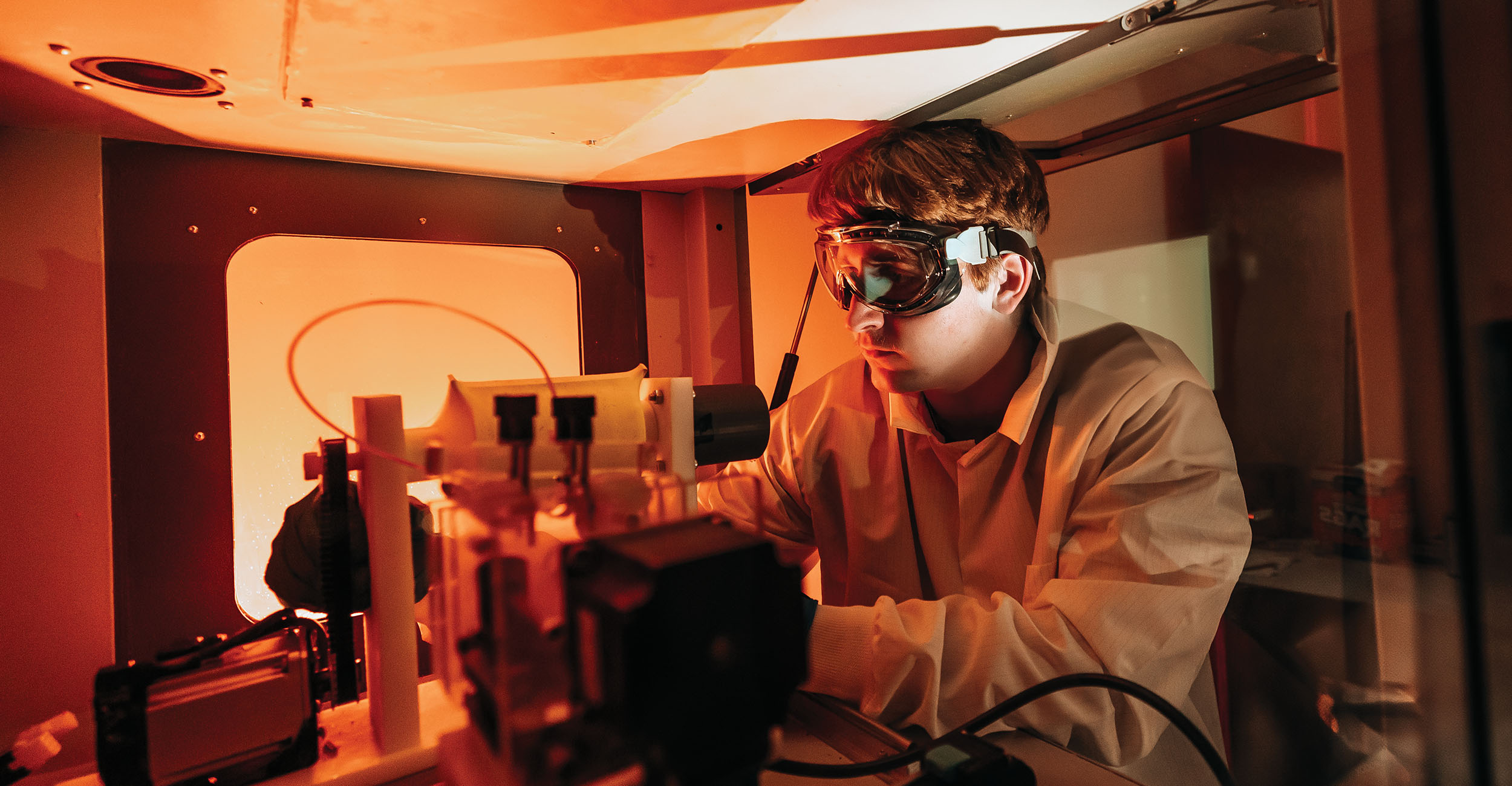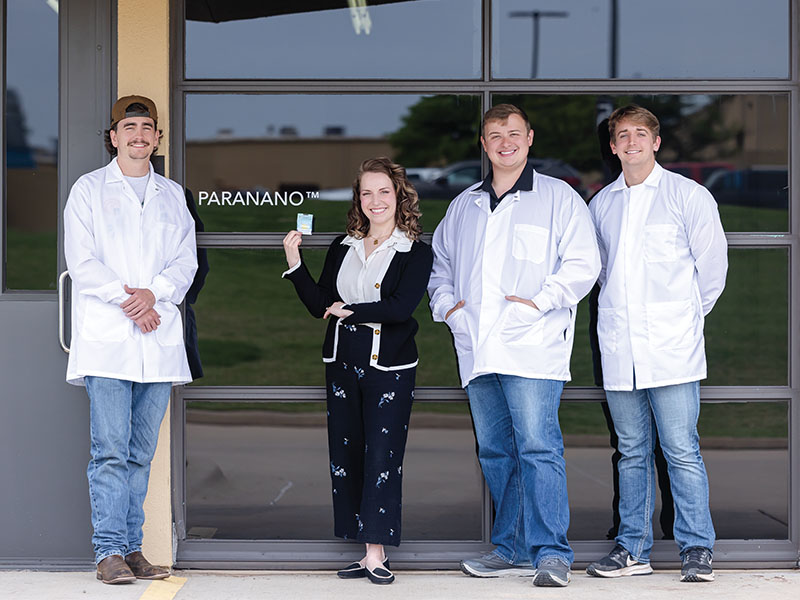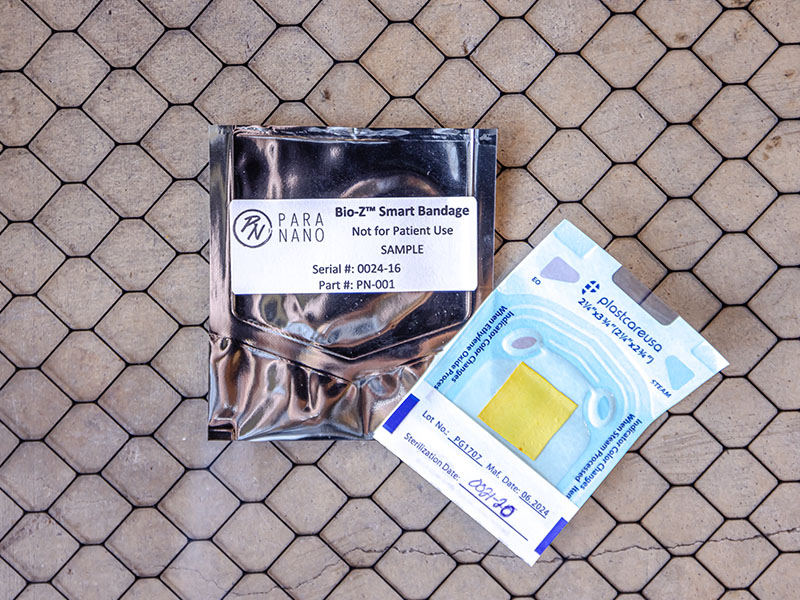
Tracking Infection: ParaNano Wound Care and the WoundCue revolution
Thursday, October 2, 2025
Media Contact: Kristi Wheeler | Manager, CEAT Marketing and Communications | 405-744-5831 | kristi.wheeler@okstate.edu
In a world where chronic wounds drain billions from the health care system, an emerging innovation is aiming to change the game.
ParaNano Wound Care, an Oklahoma company at the forefront of nanotechnology, has discovered a breakthrough solution that will forever change the way wounds are monitored and treated. This solution addresses one of the greatest challenges in medical care: infection.
It all started with an idea — a vision to close a critical gap in wound care that is causing unnecessary suffering and escalating health care costs. Chronic wounds, whether from diabetes, pressure ulcers, burns or other debilitating conditions, have always been a major problem. But despite decades of progress, one crucial issue has remained: continuous monitoring.
Between doctor visits, patients are often left in the dark, unable to detect the early signs of infection until it’s too late. There has never been a way to continuously monitor wounds for rising bacterial load, let alone one that is fast and easy to use in all care environments.
Infection in chronic wounds can be a silent killer. It doesn’t just slow the healing process; it can cause it to reverse, leading to complications like sepsis, amputations and even death. Worse, for every six-hour delay in detecting sepsis, a patient’s survival rate drops by a chilling 10%.
ParaNano Wound Care set out to solve this exact problem.
ParaNano Wound Care is a preclinical company founded in 2018. Its goal is to develop and commercialize an advanced wound care product line called the WoundCue™ with Bio-Z™ Technology.
ParaNano Wound Care holds the exclusive, worldwide patent rights to an extensive patent portfolio for the foundational technologies licensed from the University of Central Oklahoma and the University of Manitoba.
How it all began
Chelsea Luxen, entrepreneur by trade and CEO and co-founder of ParaNano Wound Care, and Maurice Haff, chief technical officer and co-founder of ParaNano Wound Care, started this journey in 2016.
They teamed up with the New Product Development Center in the College of Engineering, Architecture and Technology at Oklahoma State University to create a specialized electrospinning machine that would produce specific novel nanofiber membranes and a process for creating the membranes in a commercially viable manner.
NPDC, largely funded by the Oklahoma Center for Advancement of Science & Technology, offers a broad array of services, including engineering design and computer-aided design modeling; prototyping; manufacturing drawings and specification documents; technical research and grant/proposal writing assistance; and access to specialized lab/test equipment to entrepreneurs, inventors and manufacturers.
Luxen and Haff initially planned to sell these machines to people using nanofibers. However, that plan pivoted when they met with UM, which had researchers working with electrospun nanofibers to create a product for wound care and saw an opportunity to combine these two technologies to create something truly novel.
“The researchers at UM had taken their technology as far as possible within their existing electrospinning framework and saw a unique opportunity to advance their innovation by integrating our novel electrospinning technology,” Luxen said. “Haff and I did about nine months of due diligence with the University of Manitoba and another nine months of due diligence looking into wound care, and we realized this was going to be pretty major.”



Derby Whitefield, a design engineer at NPDC, and Dr. Robert Taylor, director of NPDC, worked closely with Luxen and Haff to build a novel electrospinning machine based on the patents licensed from UCO. The machine created radially aligned nanofibers in membranes comprising the color-changing nanofibers patented by UM and exclusively licensed to ParaNano Wound Care.
The outcome of a six-year collaboration is a scalable membrane fabrication process that is usable for commercial manufacturing of the WoundCue product. The WoundCue product enables continuous wound monitoring and provides a color-change alert at critical thresholds of bacterial presence. It is expected to be available to health care providers in 2026.
Infection in chronic wounds currently drives $27 billion of direct costs into the U.S. health care system and comprises 3% of health care costs in developed countries globally. About 8.2 million Medicare beneficiaries had at least one type of wound or related infection, and wound care is a $96.8 billion burden on Medicare.
Despite significant progress over the past decade in dealing with chronic (non-healing) wounds, there is an unaddressed gap in the wound care market.
“That meant to us that there was room for innovation,” Luxen said. “That’s how ParaNano Wound Care came to be. We had two university partners, and I said, ‘Hey, why don’t you license everything to us?’ We’ll create a new company, and we’ll commercialize this product for you.”
The solution
Months of research and countless prototypes led the team to the WoundCue — a flexible nanofiber membrane configured in a dressing that visually changes color when pathogenic activity is detected.
It’s a simple yet powerful innovation that has the potential to change the landscape of wound care. The dressing, embedded with advanced technology, is “smart.” There are no wires, no bulky devices and no batteries. It’s just a piece of fabric — elegant in its simplicity.
The magic of WoundCue lies in its ability to detect pathogenic activity. When bacterial concentrations exceed a critical threshold, the bandage visibly changes color. It’s as though the wound is sending a signal, alerting the patient or caregiver to harmful bacteria or fungi. Timely intervention can occur before bacterial load rises beyond critical, and infection takes root and spirals out of control.
“If antibiotics can be considered the fire extinguisher of medicine, then the WoundCue is the smoke detector, because it allows you to know that there’s a ‘fire’ and there’s something going on here and you need to get medical attention,” Luxen said.
The WoundCue is a color-changing membrane that interacts with the wound exudate, moisture and discharge coming out of the wound. The color change is triggered by an enzyme called lipase. Pathogenic bacteria and certain fungal strains secrete this enzyme. The lipase interacts with the nanofiber itself and is carried through the wound exudate.
When there’s a high enough concentration of that lipase, it means the bacteria present have reached a level approaching the threshold of infection; The lipase triggers the color change in the nanofiber membrane from yellow to green.
WoundCue is provided in a kit with an island foam dressing that is placed on the wound first. Then it is placed on top of that and sealed with a transparent adhesive backing that can be adhered to the foam and skin.
Making strides
In 2023, ParaNano Wound Care became the only Oklahoma Blue Knight Company, a joint initiative between Johnson & Johnson Innovation and the Biomedical Advanced Research and Development Authority focused on public health preparedness and medical countermeasures, which has provided an opportunity for ParaNano Wound Care to launch their product planned for later this year.
“We will, by the end of this year, be launched into the market,” Luxen said. “Right
now, we are gearing up for a post-market, non-significant risk clinical study in partnership
with Wound Care Plus LLC to gather data on the color-change component of the product.”
The study is funded through a Blue Knight QuickFire Challenge award.
As part of the study, participants with eligible wounds will have a sample taken and sent for quantitative analysis to determine which pathogens are present and at what thresholds. A WoundCue bandage will then be applied, and patients will be monitored for a color change over a 72-hour period.
This enables ParaNano Wound Care to correlate the color-change response with the presence and levels of specific pathogens. They will also be collecting exploratory data on whether the patient exhibited clinical signs and symptoms of infection (the current standard of care), their ranking on the Fitzpatrick scale, and human factors data.
“If antibiotics can be considered the fire extinguisher of medicine, then the WoundCue is the smoke detector, because it allows you to know that there’s a ‘fire’ and there’s something going on here and you need to get medical attention.”
“Once we have that data, we’ll be able to answer our committed first order,” Luxen said. “The United States Department of Veterans Affairs will be our first customer. We also just secured a contract with the Defense Health Agency and the Military Burn Research Program, which has competitively awarded us nearly $3 million to refine our products for use in traumatic burn injury in role 1 and austere environments, not only in civilian life, but also military life too.”
Luxen said that by next year they are hoping to get full market penetration. They will start off as a business-to-business launch and then hopefully the product will be accessible to everyone who has a wound.
As the world continues to embrace the possibilities of nanotechnology, ParaNano Wound Care remains a beacon of innovation and hope. With every bandage they release, they won’t just be offering solutions — they will be transforming how the world thinks about health care.
Ultimately, it isn’t just about treating wounds or managing diseases; it’s about preventing suffering, saving lives and making health care a more accessible, connected experience for everyone.
This material is based upon work supported by the Defense Health Agency Small Business
Innovation Research/Small Business Technology Transfer Programs/US Army Medical Research
and Development under US Army Medical Research Acquisition Activity Contract No. HT9425-25-C-0014
Any opinions, findings, and conclusions or recommendations expressed in this material
are those of the author(s) and do not necessarily reflect the views of the Department
of Defense, DHA SBIR/STTR Programs, USAMRDC, or USAMRAA.
Photos by: Ellie Piper
Story by: Kristi Wheeler | IMPACT Magazine
